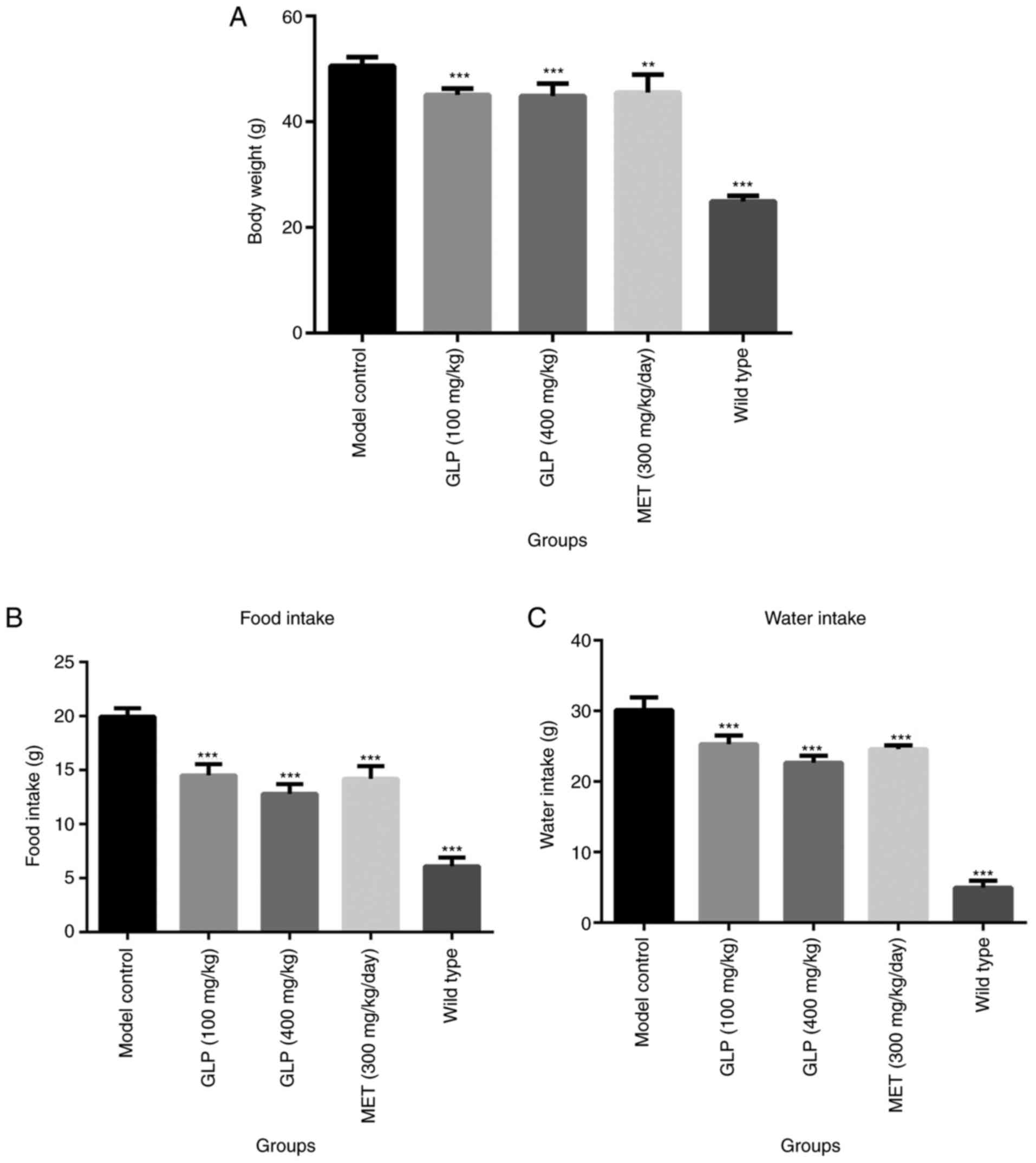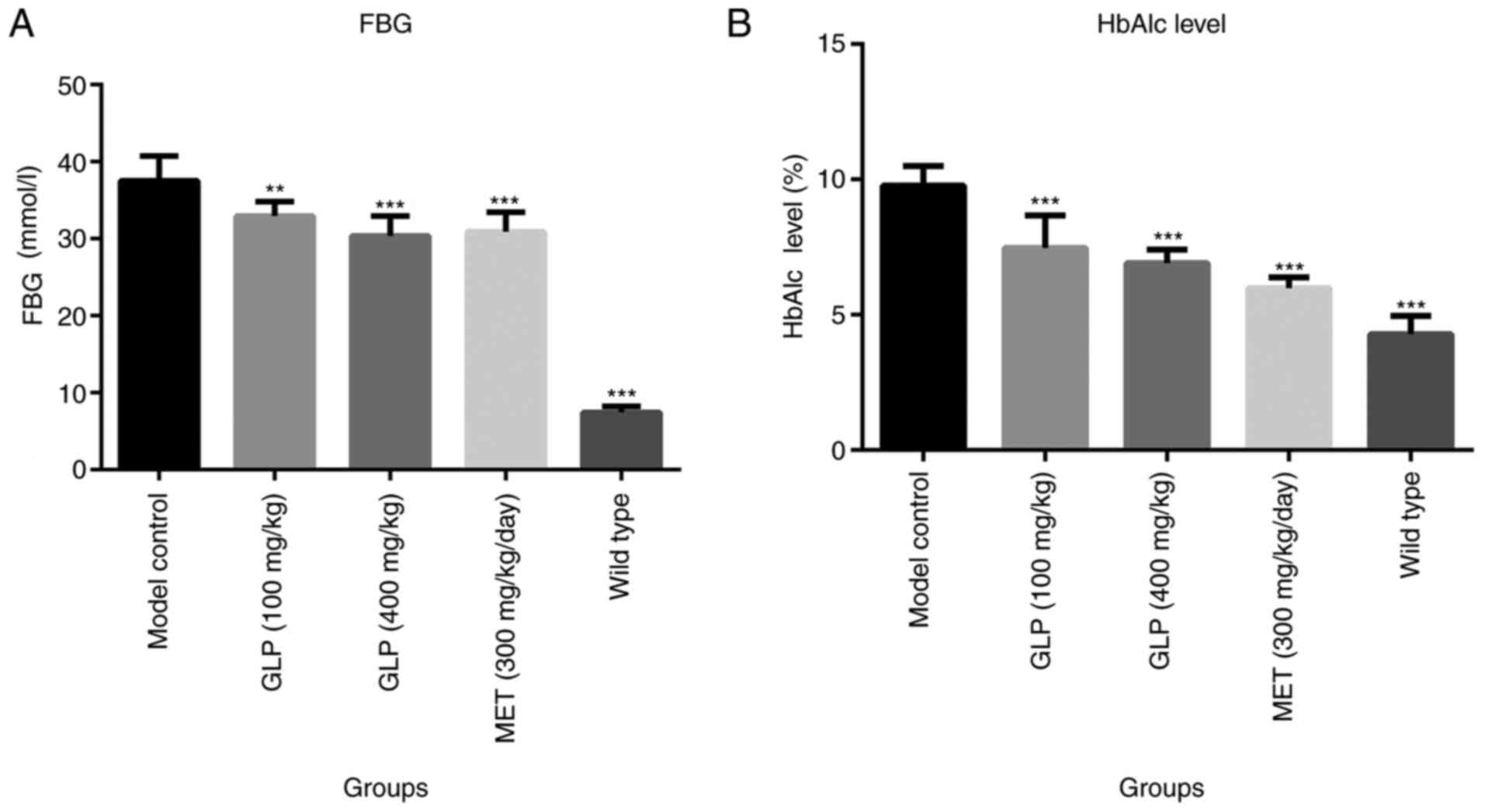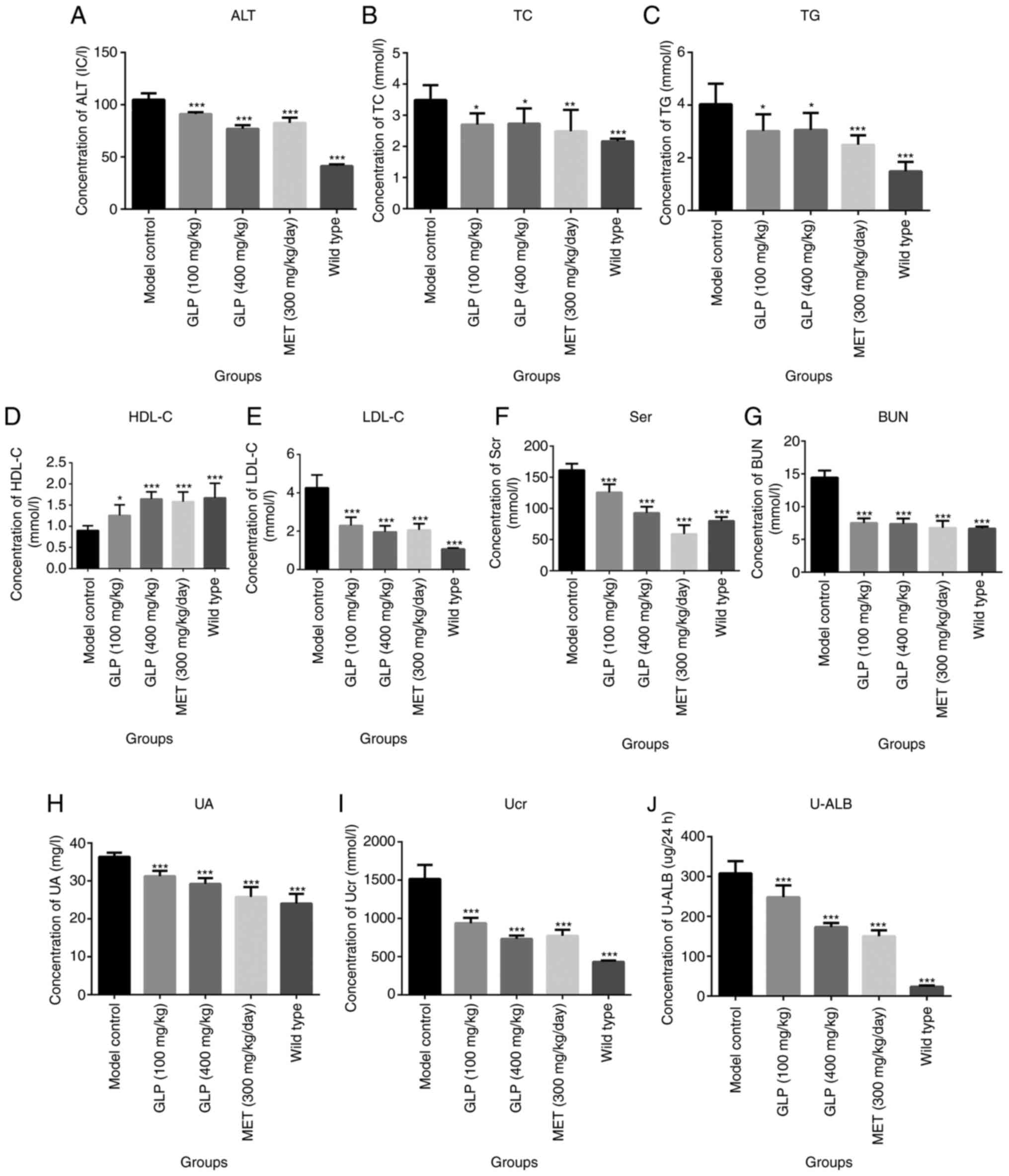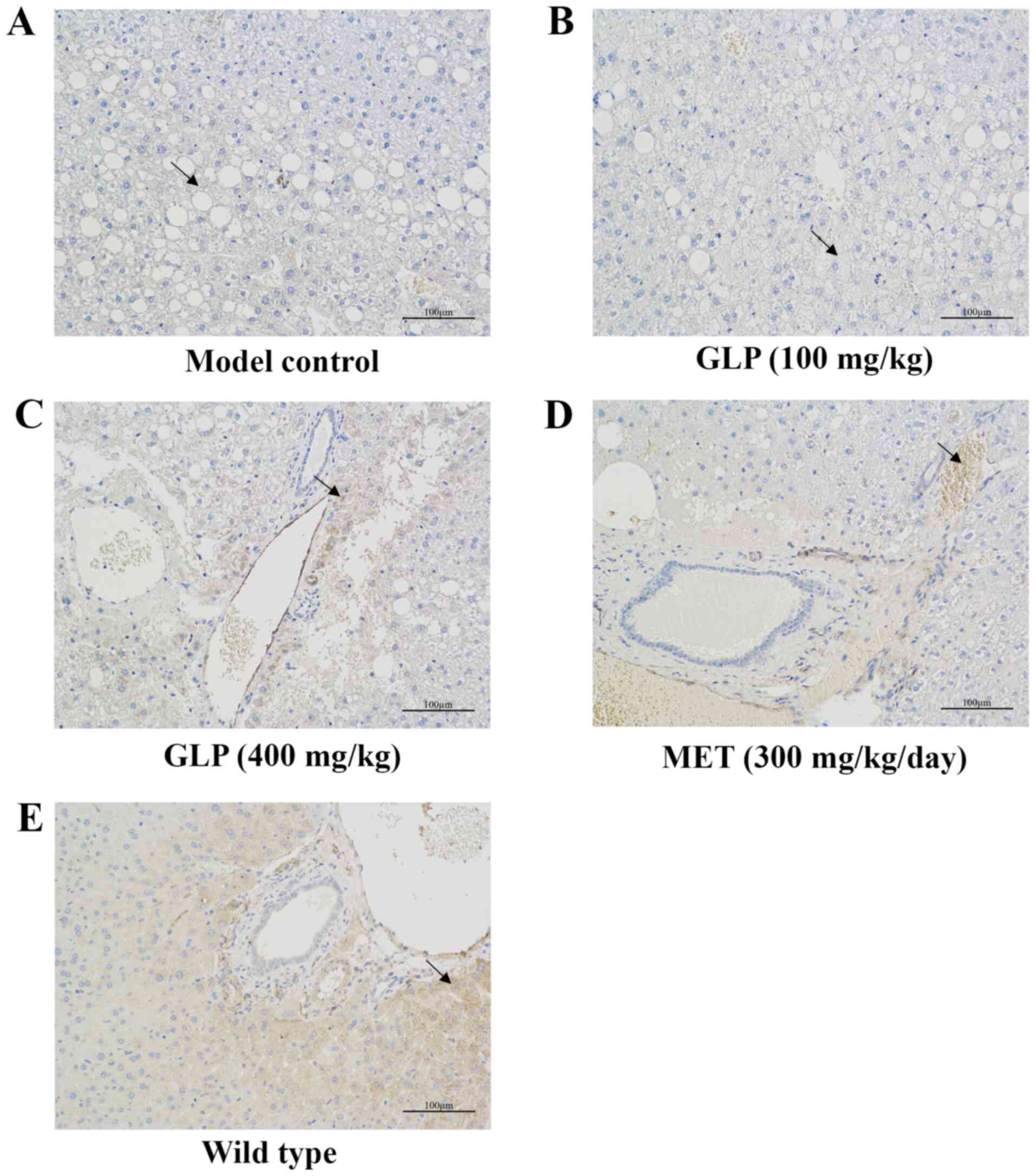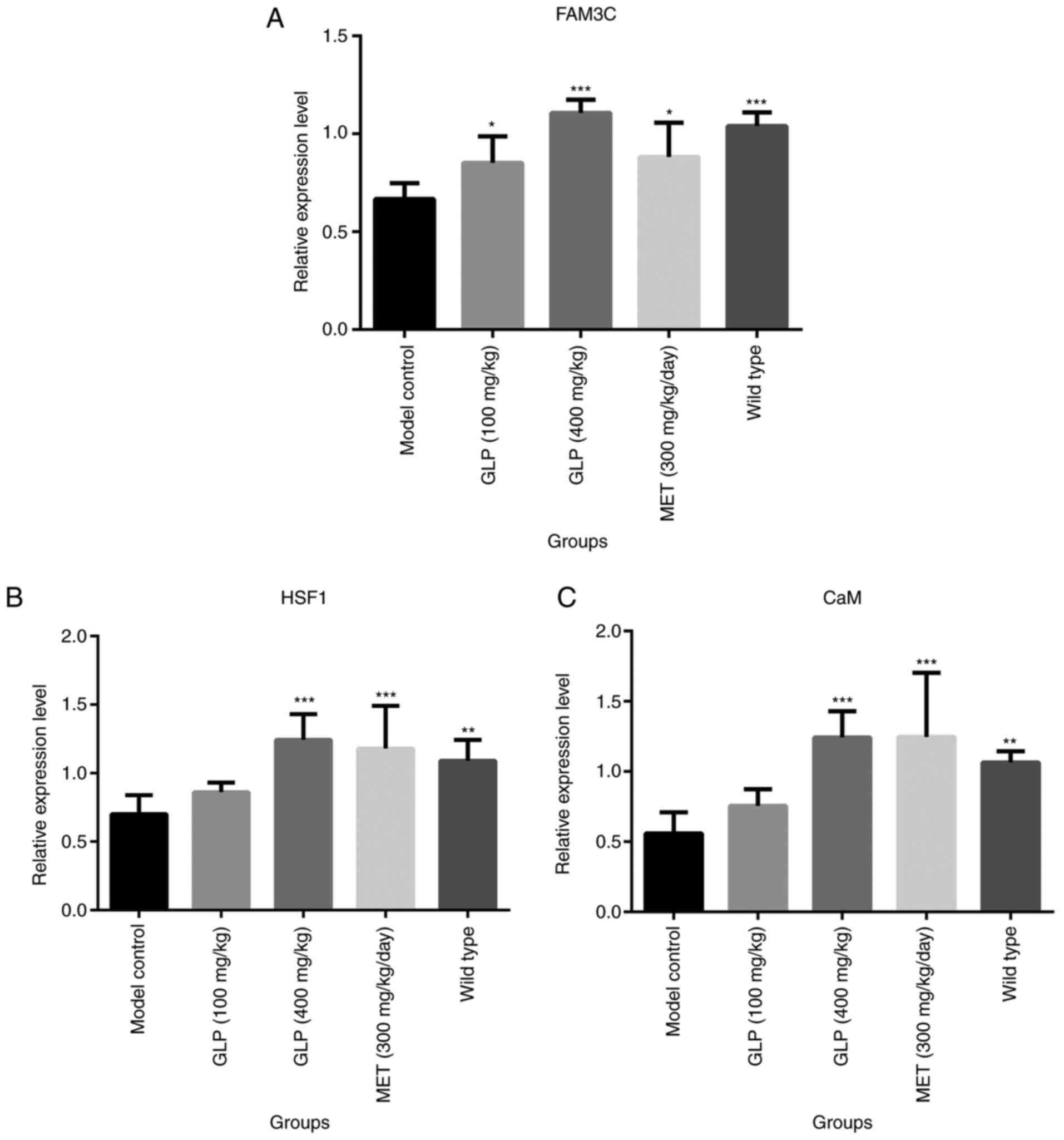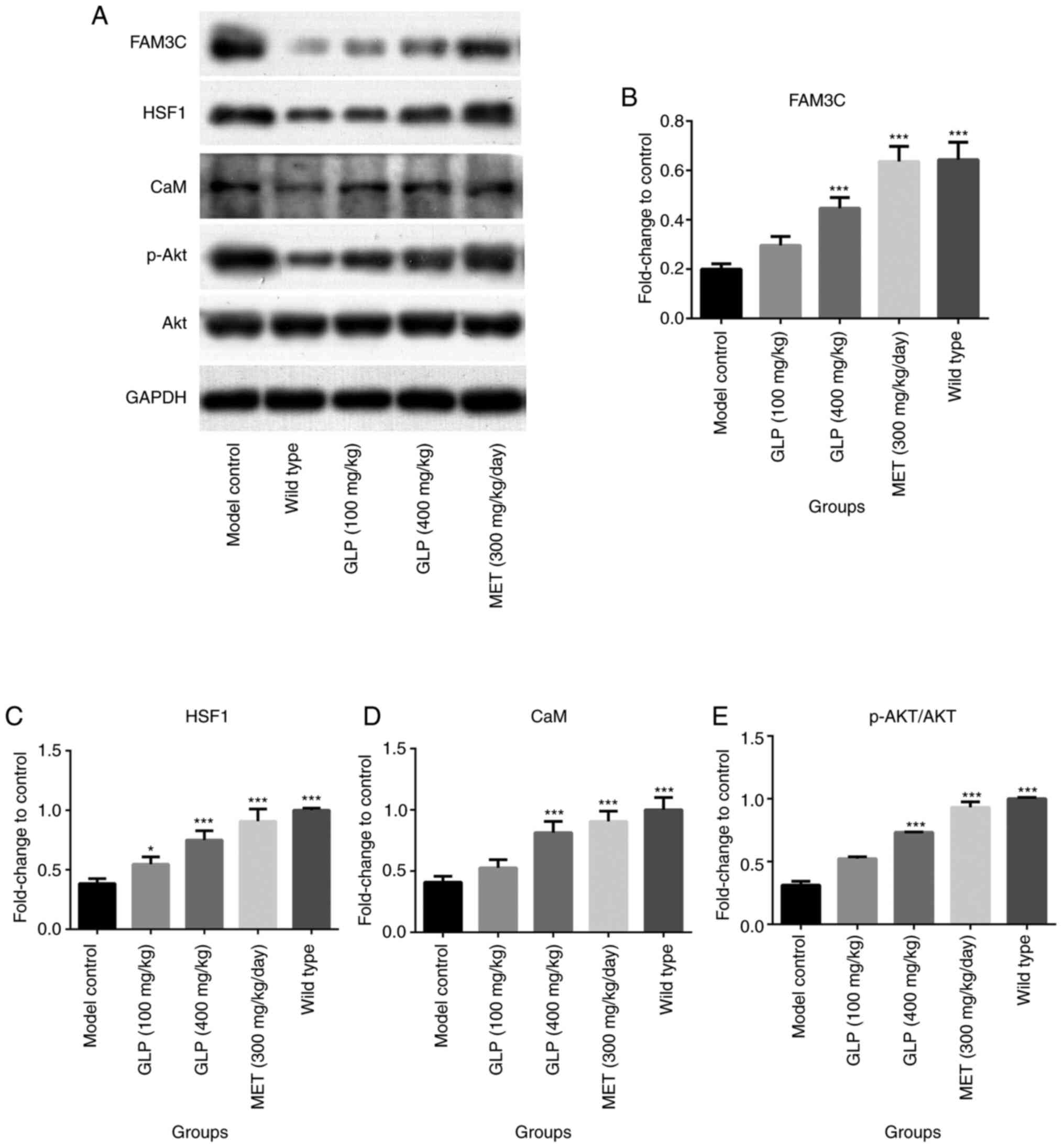|
1
|
Zhu J, Zhang X, Zhang X, Dong M, Wu J,
Dong Y, Chen R, Ding X, Huang C, Zhang Q and Zhou W: The burden of
ambient air pollution on years of life lost in Wuxi, China,
2012-2015: A time-series study using a distributed lag non-linear
model. Environ Pollut. 224:689–697. 2017.PubMed/NCBI View Article : Google Scholar
|
|
2
|
Patil P, Mandal S, Tomar SK and Anand S:
Food protein-derived bioactive peptides in management of type 2
diabetes. Eur J Nutr. 54:863–880. 2015.PubMed/NCBI View Article : Google Scholar
|
|
3
|
Garber AJ, Abrahamson MJ, Barzilay JI,
Blonde L, Bloomgarden ZT, Bush MA, Dagogo-Jack S, DeFronzo RA,
Einhorn D, Fonseca VA, et al: Consensus statement by the American
Association of clinical endocrinologists and American college of
endocrinology on the comprehensive type 2 diabetes management
algorithm-2019 executive summary. Endocr Pract. 25:69–100.
2019.PubMed/NCBI View Article : Google Scholar
|
|
4
|
He K, Shi JC and Mao XM: Safety and
efficacy of acarbose in the treatment of diabetes in Chinese
patients. Ther Clin Risk Manag. 10:505–511. 2014.PubMed/NCBI View Article : Google Scholar
|
|
5
|
Abe M, Okada K, Maruyama T, Maruyama N and
Matsumoto K: Combination therapy with mitiglinide and voglibose
improves glycemic control in type 2 diabetic patients on
hemodialysis. Expert Opin Pharmacother. 11:169–176. 2010.PubMed/NCBI View Article : Google Scholar
|
|
6
|
Kirschner LS, Qamri Z, Kari S and Ashtekar
A: Mouse models of thyroid cancer: A 2015 update. Mol Cell
Endocrinol. 421:18–27. 2016.PubMed/NCBI View Article : Google Scholar
|
|
7
|
Ali MY, Zaib S, Rahman MM, Jannat S, Iqbal
J, Park SK and Chang MS: Didymin, a dietary citrus flavonoid
exhibits anti-diabetic complications and promotes glucose uptake
through the activation of PI3K/Akt signaling pathway in
insulin-resistant HepG2 cells. Chem Biol Interact. 305:180–194.
2019.PubMed/NCBI View Article : Google Scholar
|
|
8
|
Asano N, Yamashita T, Yasuda K, Ikeda K,
Kizu H, Kameda Y, Kato A, Nash RJ, Lee HS and Ryu KS:
Polyhydroxylated alkaloids isolated from mulberry trees (Morus
alba L.) and silkworms (Bombyx mori L.). J Agric Food
Chem. 49:4208–4213. 2001.PubMed/NCBI View Article : Google Scholar
|
|
9
|
Chehade JM and Mooradian AD: A rational
approach to drug therapy of type 2 diabetes mellitus. Drugs.
60:95–113. 2000.PubMed/NCBI View Article : Google Scholar
|
|
10
|
Lorenzo PI, Juárez-Vicente F,
Cobo-Vuilleumier N, Garcia-Dominguez M and Gauthier BR: The
diabetes-linked transcription factor PAX4: From gene to functional
consequences. Genes (Basel). 8(101)2017.PubMed/NCBI View Article : Google Scholar
|
|
11
|
Omori K, Kobayashi E, Rawson J, Takahashi
M and Mullen Y: Mechanisms of islet damage mediated by pancreas
cold ischemia/rewarming. Cryobiology. 73:126–134. 2016.PubMed/NCBI View Article : Google Scholar
|
|
12
|
Beattie GM, Leibowitz G, Lopez AD, Levine
F and Hayek A: Protection from cell death in cultured human fetal
pancreatic cells. Cell Transplant. 9:431–438. 2000.PubMed/NCBI View Article : Google Scholar
|
|
13
|
Xue YF, Guo CZ, Hu F, Sun DM, Liu JH and
Mao SY: Molecular mechanisms of lipid metabolism disorder in livers
of ewes with pregnancy toxemia. Animal. 13:992–999. 2019.PubMed/NCBI View Article : Google Scholar
|
|
14
|
Kaneko YK: Development and analysis of
novel therapeutic targets to improve pancreatic β-cell function in
type 2 diabetes. Yakugaku Zasshi. 136:1623–1629. 2016.PubMed/NCBI View Article : Google Scholar : (In Japanese).
|
|
15
|
Langley AK, Suffoletta TJ and Jennings HR:
Dipeptidyl peptidase IV inhibitors and the incretin system in type
2 diabetes mellitus. Pharmacotherapy. 27:1163–1180. 2007.PubMed/NCBI View Article : Google Scholar
|
|
16
|
Somtimuang C, Olatunji OJ and Ovatlarnporn
C: Evaluation of in vitro α-amylase and α-glucosidase inhibitory
potentials of 14 medicinal plants constituted in thai folk
antidiabetic formularies. Chem Biodivers.
15(e1800025)2018.PubMed/NCBI View Article : Google Scholar
|
|
17
|
Wu H, Liu J, Lou Q, Liu J, Shen L, Zhang
M, Lv X, Gu M and Guo X: Comparative assessment of the efficacy and
safety of acarbose and metformin combined with premixed insulin in
patients with type 2 diabetes mellitus. Medicine (Baltimore).
96(e7533)2017.PubMed/NCBI View Article : Google Scholar
|
|
18
|
Xu J and Rajaratnam R: Cardiovascular
safety of non-insulin pharmacotherapy for type 2 diabetes.
Cardiovasc Diabetol. 16(18)2017.PubMed/NCBI View Article : Google Scholar
|
|
19
|
Laoud A, Ferkous F, Maccari L, Maccari G,
Saihi Y and Kraim K: Identification of novel nt-MGAM inhibitors for
potential treatment of type 2 diabetes: Virtual screening, atom
based 3D-QSAR model, docking analysis and ADME study. Comput Biol
Chem. 72:122–135. 2018.PubMed/NCBI View Article : Google Scholar
|
|
20
|
Men P, Li XT, Tang HL and Zhai SD:
Efficacy and safety of saxagliptin in patients with type 2
diabetes: A systematic review and meta-analysis. PLoS One.
13(e0197321)2018.PubMed/NCBI View Article : Google Scholar
|
|
21
|
Min SH, Yoon JH, Hahn S and Cho YM:
Efficacy and safety of combination therapy with an α-glucosidase
inhibitor and a dipeptidyl peptidase-4 inhibitor in patients with
type 2 diabetes mellitus: A systematic review with meta-analysis. J
Diabetes Investig. 9:893–902. 2018.PubMed/NCBI View Article : Google Scholar
|
|
22
|
Chiefari E, Arcidiacono B, Foti D and
Brunetti A: Gestational diabetes mellitus: An updated overview. J
Endocrinol Invest. 40:899–909. 2017.PubMed/NCBI View Article : Google Scholar
|
|
23
|
Chen Y, Qiao J, Luo J, Wu F, Meng G, Chen
H, Zheng H and Xu J: Effects of Ganoderma lucidum
polysaccharides on advanced glycation end products and receptor of
aorta pectoralis in T2DM rats. Zhongguo Zhong Yao Za Zhi.
36:624–627. 2011.PubMed/NCBI(In Chinese).
|
|
24
|
Teng BS, Wang CD, Yang HJ, Wu JS, Zhang D,
Zheng M, Fan ZH, Pan D and Zhou P: A protein tyrosine phosphatase
1B activity inhibitor from the fruiting bodies of Ganoderma
lucidum (Fr.) Karst and its hypoglycemic potency on
streptozotocin-induced type 2 diabetic mice. J Agric Food Chem.
59:6492–6500. 2011.PubMed/NCBI View Article : Google Scholar
|
|
25
|
Tamez-Pérez HE, Gonzalez-Guajardo EE and
Tamez-Peña AL: Re: Consensus statement by the American association
of clinical endocrinologists and American college of endocrinology
on the comprehensive type 2 diabetes management algorithm-2019
executive summary. Endocr Pract. 25(622)2019.PubMed/NCBI View Article : Google Scholar
|
|
26
|
Shen L, Ao L, Xu H, Shi J, You D, Yu X, Xu
W, Sun J and Wang F: Poor short-term glycemic control in patients
with type 2 diabetes impairs the intestinal mucosal barrier: A
prospective, single-center, observational study. BMC Endocr Disord.
19(29)2019.PubMed/NCBI View Article : Google Scholar
|
|
27
|
Zhang X, Yang W, Wang J, Meng Y, Guan Y
and Yang J: FAM3 gene family: A promising therapeutical target for
NAFLD and type 2 diabetes. Metabolism. 81:71–82. 2018.PubMed/NCBI View Article : Google Scholar
|
|
28
|
Chen Z, Wang J, Yang W, Chen J, Meng Y,
Feng B, Chi Y, Geng B, Zhou Y, Cui Q and Yang J: FAM3C activates
HSF1 to suppress hepatic gluconeogenesis and attenuate
hyperglycemia of type 1 diabetic mice. Oncotarget. 8:106038–106049.
2017.PubMed/NCBI View Article : Google Scholar
|
|
29
|
Zhao X, Li J, Liu Y, Wu D, Cai P and Pan
Y: Structural characterization and immunomodulatory activity of a
water soluble polysaccharide isolated from Botrychium
ternatum. Carbohydr Polym. 171:136–142. 2017.PubMed/NCBI View Article : Google Scholar
|
|
30
|
Livak KJ and Schmittgen TD: Analysis of
relative gene expression data using real-time quantitative PCR and
the 2(-Delta Delta C(T)) method. Methods. 25:402–408.
2001.PubMed/NCBI View Article : Google Scholar
|
|
31
|
Liu Y, Zhang C, Du J, Jia R, Cao L, Jeney
G, Teraoka H, Xu P and Yin G: Protective effect of Ganoderma
lucidum polysaccharide against carbon tetrachloride-induced
hepatic damage in precision-cut carp liver slices. Fish Physiol
Biochem. 43:1209–1221. 2017.PubMed/NCBI View Article : Google Scholar
|
|
32
|
Rashad FM, Kattan MHE, Fathy HM, El-Fattah
DAA, Tohamy ME and Farahat AA: Recycling of agro-wastes for
Ganoderma lucidum mushroom production and Ganoderma
post mushroom substrate as soil amendment. Waste Manag. 88:147–159.
2019.PubMed/NCBI View Article : Google Scholar
|
|
33
|
Wan Y, Wang Q and Prud'homme GJ: GABAergic
system in the endocrine pancreas: A new target for diabetes
treatment. Diabetes Metab Syndr Obes. 8:79–87. 2015.PubMed/NCBI View Article : Google Scholar
|
|
34
|
Singh P, Jayaramaiah RH, Agawane SB,
Vannuruswamy G, Korwar AM, Anand A, Dhaygude VS, Shaikh ML, Joshi
RS, Boppana R, et al: Potential dual role of eugenol in inhibiting
advanced glycation end products in diabetes: Proteomic and
mechanistic insights. Sci Rep. 6(18798)2016.PubMed/NCBI View Article : Google Scholar
|
|
35
|
Xue H, Qiao J, Meng G, Wu F, Luo J, Chen
H, Zheng H and Xu J: Effect of Ganoderma lucidum
polysaccharides on hemodynamic and antioxidation in T2DM rats.
Zhongguo Zhong Yao Za Zhi. 35:339–343. 2010.PubMed/NCBI View Article : Google Scholar : (In Chinese).
|
|
36
|
Li HN, Zhao LL, Zhou DY and Chen DQ:
Ganoderma lucidum polysaccharides ameliorates hepatic
steatosis and oxidative stress in db/db mice via targeting nuclear
factor E2 (erythroid-derived 2)-related factor-2/heme oxygenase-1
(HO-1) pathway. Med Sci Monit. 26(e921905)2020.PubMed/NCBI View Article : Google Scholar
|
|
37
|
Chen M, Xiao D, Liu W, Song Y, Zou B, Li
L, Li P, Cai Y, Liu D, Liao Q and Xie Z: Intake of Ganoderma
lucidum polysaccharides reverses the disturbed gut microbiota
and metabolism in type 2 diabetic rats. Int J Biol Macromol.
155:890–902. 2020.PubMed/NCBI View Article : Google Scholar
|
|
38
|
Chang CJ, Lin CS, Lu CC, Martel J, Ko YF,
Ojcius DM, Tseng SF, Wu TR, Chen YY, Young JD and Lai HC:
Ganoderma lucidum reduces obesity in mice by modulating the
composition of the gut microbiota. Nat Commun.
6(7489)2015.PubMed/NCBI View Article : Google Scholar
|
|
39
|
Ma HT, Hsieh JF and Chen ST: Anti-diabetic
effects of Ganoderma lucidum. Phytochemistry. 114:109–113.
2015.PubMed/NCBI View Article : Google Scholar
|
|
40
|
Adeyemi WJ, Olayaki LA, Abdussalam TA,
Fabiyi TO, Raji TL and Adetunji AA: Co-administration of omega-3
fatty acids and metformin showed more desirable effects than the
single therapy on indices of bone mineralisation but not
gluco-regulatory and antioxidant markers in diabetic rats. Biomed
Pharmacother. 121(109631)2020.PubMed/NCBI View Article : Google Scholar
|
|
41
|
Xiao C, Wu QP, Cai W, Tan JB, Yang XB and
Zhang JM: Hypoglycemic effects of Ganoderma lucidum
polysaccharides in type 2 diabetic mice. Arch Pharm Res.
35:1793–1801. 2012.PubMed/NCBI View Article : Google Scholar
|
|
42
|
Xiao C, Wu Q, Zhang J, Xie Y, Cai W and
Tan J: Antidiabetic activity of Ganoderma lucidum
polysaccharides F31 down-regulated hepatic glucose regulatory
enzymes in diabetic mice. J Ethnopharmacol. 196:47–57.
2017.PubMed/NCBI View Article : Google Scholar
|















